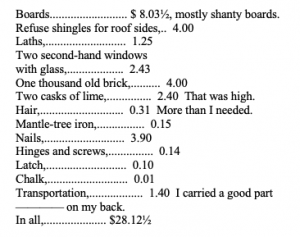“I have thus a tight shingled and plastered house, ten feet wide by fifteen long, and eight-feet posts, with a garret and a closet, a large window on each side, two trap doors, one door at the end, and a brick fireplace opposite. The exact cost of my house, paying the usual price for such materials as I used, but not counting the work, all of which was done by myself, was as follows; and I give the details because very few are able to tell exactly what their houses cost, and fewer still, if any, the separate cost of the various materials which compose them:”

Throughout Thoreau’s book he incorporates bookkeeping tables that represents the expenses that he pays while in the woods, but also the profit he gets from doing various tasks (ex. working on the bean fields). One particular passage and bookkeeping table that stood out to me was in the chapter called “Economy” where Thoreau outlines his expenses for the cabin he builds himself. I think Thoreau’s use of the table highlights not only does he want to live a lifestyle where he does not incur a lot of debt, but also, the fact that he does not need to buy new material to feel content with his house. In general, Thoreau’s inclusion of tables throughout the book sheds light on his desire to avoid and essentially restrain himself from giving into the consumer society that his fellow peers and community members are so actively engaged in.

I agree with this point Mei— a lot of “Economy” is spent discussing consumerism. I think you could argue that one reason he includes such meticulous details, other than a simple recounting of his life/experiences, is to foil frivolous behavior. It seems that the table shows the simplicity of his lifestyle and makes the average consumer think about their behavior when in a similar situation. This table makes the reader reflect on their personal decisions and likely opens their eyes to different ways of living. I think one of the main ways Thoreau gets his points across is by making the reader self reflect.